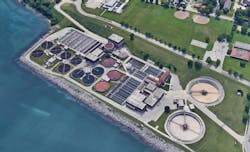About the author:
Cristina Tuser is Associate Editor for WWD. Tuser can be reached at [email protected]
Located on the shore of Lake Michigan in Racine County, Wisconsin, the Racine Wastewater Treatment Plant provides wastewater treatment for eight satellite communities.
The design capacity is 36 million gallons per day (mgd) and the plant capacity is 108 mgd. There are two flow equalization basins, each with a capacity of 100 million gallons. Theoretically, it is possible to treat 308 million gallons of water, but typically when there is heavy rain, it is between 150 to 180 mgd.
Staff Takes Pride
The plant’s system is old, there is a lot of inflow and infiltration during rain events; so much in fact that it surprises new operators.
“When we’ve had a lot of rain, more typical is probably between 150 and 180 mgd, and that’s a lot of water!” said Mary-Frances Klimek, Racine Wastewater Utility Superintendent. “When we have new operators in and they see all of that coming through that diversion structure, you usually see that look of shock on their face. I wouldn’t say it’s panic, they know what to do, but they’ve never seen that amount at one time before.”
Due to flow challenges, especially those during rain events, construction and upgrades are generally centered on flow management. The facility’s staff is prepared for anything, however. From unforeseen events and unexpected rain to simple adjustments, operator flexibility is a point of pride.
“I am most proud of the people that I work with. We have a group of people that take what they do very seriously,” said Mary-Frances Klimek, Racine Wastewater Utility Superintendent. “Our goal everyday is to put the best effluent that we can from our plant to Lake Michigan, as well as the emission put to the air. Our people have solved problems that many plants bring contractors in to take care of.”
The Racine Wastewater Utility discharges effluent to Lake Michigan. Two lines come into the plant, one from the north side and one from the south side. At the front of the plant ferric chloride is added for phosphorus limit, which helps with H2S reduction.
Racine WWTP Flow
The flow comes to a diversion structure and proceeds through the preliminary and pretreatment building. The plant has two vortex grit removal units at 70 mgd each to remove coarse abrasive inorganic material continuously from the screened water flow.
The preliminary treatment building contains four bar screens, each with a rated maximum capacity of 35 mgd. The sludge passes through each of those and then through one of 12 primary clarifiers. The clarifiers are divided on the east and west sides. The plant alternates between these throughout the day. This is done because the nutrient removal for 12 clarifiers is too great and they do not have enough biochemical oxygen demand for the back of the plant.
From the primary clarifier, the sludge is pumped from the bottom of the tank through one of four digesters, and then the solids portions from those digesters has a detention time of approximately 4 to 5 days. From there, sludge goes to a holding tank, which used to be a secondary digester. The sludge is then pulled from the holding tank to the belt filter press of which there are six.
From the belt pressers, the sludge goes to one of two trucks, and the cake is hauled to either a storage building or a farm.
As the water leaves the primary clarifiers, the primary effluent flows through a channel to the back of the plant, where it enters the aeration system. There are five aeration tanks which have an approximate volume of 1 mgd each for approximately 5 mgd of aeration capacity. From there, the flow goes to one of nine final clarifiers, before entering one of two ultraviolet (UV) disinfection systems. From here, the water discharges to Lake Michigan.
In The Home Stretch
The Racine Wastewater Treatment Plant is in the final completion phase of a 20-year Facility Plan. This phase involves an aeration project, replacing fine bubble diffusers with membrane diffusers. The plan also includes a new UV system, new engines, blowers, an engine generator and a biogas cleaning system. The team also plans to add launder covers. Recently, the team completed repairing a digester cover and adding a walkway between two of the primary clarifiers. As the fourth largest plant in Wisconsin, the plant and collection system teams can crossover.
The plant has redundancy for most of its equipment and operation, Klimek added. The team also has an inclusive training program for everything from operation, maintenance and safety of all equipment and processes both at the plant and in the collection system.
